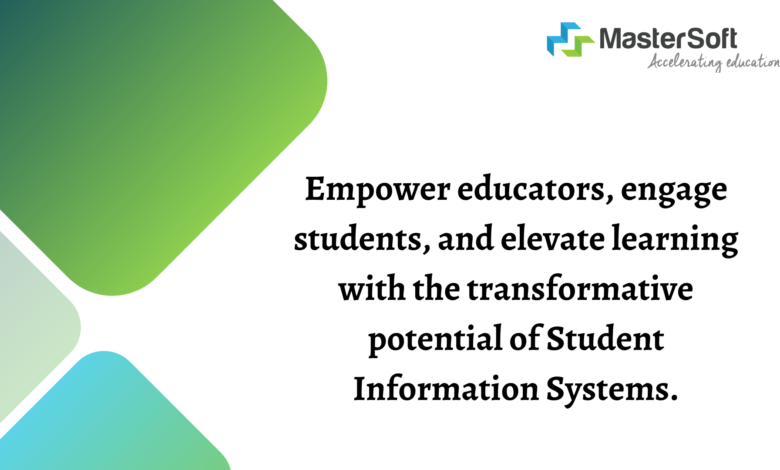Academic Potential: The Role of Student Information System

Empowering Education with Technology
In today’s rapidly evolving educational landscape, the integration of technology has become indispensable to streamline processes, enhance communication, and improve learning outcomes. Among the myriad technological advancements, Student Information System (SIS) stand out as essential tools that revolutionize how educational institutions manage student data and optimize academic operations. This comprehensive blog explores the multifaceted benefits and functionalities of SIS in maximizing academic potential and shaping the future of education.
Evolution of Student Information Systems
The evolution of Student Information Systems has been nothing short of remarkable. What began as basic databases for student records has transformed into sophisticated platforms offering comprehensive student management solutions. Over the years, SIS have embraced technological advancements such as cloud computing, data analytics, and artificial intelligence, enabling educational institutions to streamline administrative processes, improve data accuracy, and enhance student engagement.
Simplifying Administrative Tasks
Administrative tasks are the backbone of educational institutions, yet they can be time-consuming and prone to errors when managed manually. With SIS, administrative tasks such as enrollment, scheduling, and grade management are streamlined and automated. From online registration portals to automated grading systems, SIS empower educators and administrators to focus more on strategic initiatives and student support services, ultimately fostering a more efficient and productive learning environment.
Enhancing Communication and Collaboration
Effective communication and collaboration are essential components of a successful educational ecosystem. SIS serve as centralized platforms that facilitate seamless communication among students, parents, teachers, and administrators. Features such as messaging systems, discussion forums, and parent portals enable stakeholders to stay connected, share information, and collaborate on academic initiatives. By promoting transparency and fostering a sense of community, SIS strengthen the partnership between home and school, ultimately contributing to student success.
Personalizing Learning Experiences
One size does not fit all in education, and SIS recognize the importance of personalized learning experiences. By capturing and analyzing student data such as learning styles, interests, and academic performance, SIS enable educators to tailor instruction to meet the diverse needs of individual learners. Whether through adaptive learning platforms, differentiated instruction models, or personalized learning pathways, SIS empower educators to create dynamic and engaging learning experiences that maximize student potential and promote academic achievement.
Supporting Data-Driven Decision Making
Data-driven decision making has become a cornerstone of effective educational leadership. SIS provide educators and administrators with valuable insights through robust data analytics and reporting capabilities. By analyzing student performance trends, identifying areas for improvement, and assessing program effectiveness, institutions can make informed decisions to enhance teaching and learning outcomes. Whether it’s adjusting curriculum standards, allocating resources, or implementing intervention strategies, SIS enable institutions to prioritize initiatives that positively impact student success.
Promoting Student Success and Retention
Student success and retention are paramount goals for educational institutions, and SIS play a pivotal role in achieving these objectives. With features such as early alert systems, academic advising tools, and predictive analytics, SIS enable institutions to identify at-risk students early on and provide targeted interventions and support services. Whether it’s academic tutoring, counseling services, or mentorship programs, SIS facilitate proactive measures that empower students to overcome challenges and persist on their educational journey.
Ensuring Compliance and Accountability
Compliance with educational policies and regulations is essential to maintaining the integrity and reputation of educational institutions. SIS help institutions ensure compliance by automating processes such as reporting, accreditation, and financial aid management. By centralizing data and implementing robust security measures, SIS reduce the risk of non-compliance and ensure accountability at all levels of the organization. Whether it’s adhering to FERPA regulations, maintaining accreditation standards, or managing federal funding requirements, SIS provide the framework for institutional compliance and transparency.
Embracing the Future of Education
As technology continues to advance, so too will the capabilities of Student Information Systems. From AI-powered learning analytics to blockchain-based credentialing, the future of SIS holds immense promise in transforming education and empowering learners to thrive in an increasingly complex and interconnected world. Educational institutions must embrace innovation and leverage SIS as catalysts for change, continually adapting to meet the evolving needs of students and society. By embracing the future of education, institutions can unlock new opportunities for innovation, collaboration, and student success.
Integration with Learning Management System
Integration between Student Information Systems (SIS) and Learning Management Systems (LMS) offers a seamless educational experience for both educators and students. By synchronizing data between these two platforms, institutions can streamline course enrollment, access student grades and assignments, and track academic progress in real-time. This integration fosters collaboration, enhances communication, and provides a centralized hub for managing all aspects of the teaching and learning process. Whether it’s delivering course materials, facilitating online discussions, or assessing student performance, the synergy between SIS and LMS creates a cohesive learning ecosystem that empowers educators to deliver high-quality instruction and enables students to engage actively in their academic journey.
Continuous Improvement and Professional Development
The implementation of Student Information Systems (SIS) is not the end of the journey but rather the beginning of a continuous improvement process. Educational institutions must invest in ongoing training and professional development to maximize the potential of SIS and ensure its effective utilization by educators and administrators. Professional development opportunities may include workshops, webinars, and certification programs focused on SIS functionality, data analysis, and best practices in educational leadership. By empowering staff with the knowledge and skills needed to leverage SIS effectively, institutions can drive innovation, optimize processes, and ultimately enhance student outcomes. Additionally, regular feedback mechanisms and user forums can provide valuable insights for system enhancements and updates, ensuring that SIS evolves in alignment with the changing needs of educational stakeholders.
Conclusion: Harnessing the Power of Student Information System
In conclusion, Student Information Systems have revolutionized education by streamlining administrative tasks, enhancing communication and collaboration, personalizing learning experiences, supporting data-driven decision making, promoting student success and retention, ensuring compliance and accountability, and embracing technological innovation. As educational institutions continue to navigate the challenges and opportunities of the digital age, SIS will remain essential tools in maximizing academic potential and preparing students for success in the 21st century and beyond. By harnessing the power of SIS, institutions can create dynamic, inclusive, and student-centered learning environments that empower all learners to reach their full potential.
Read More Blog Here




